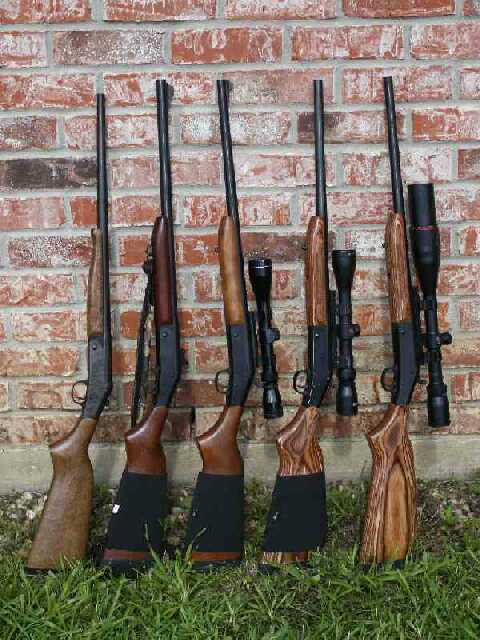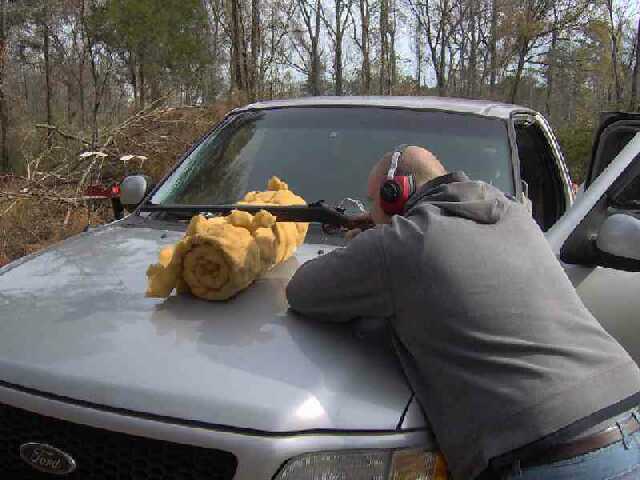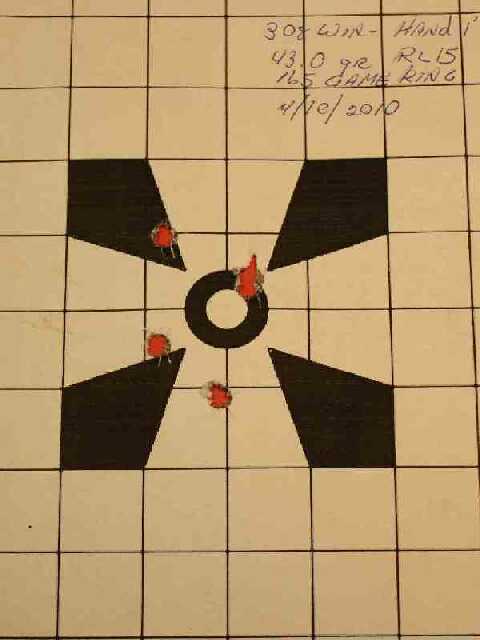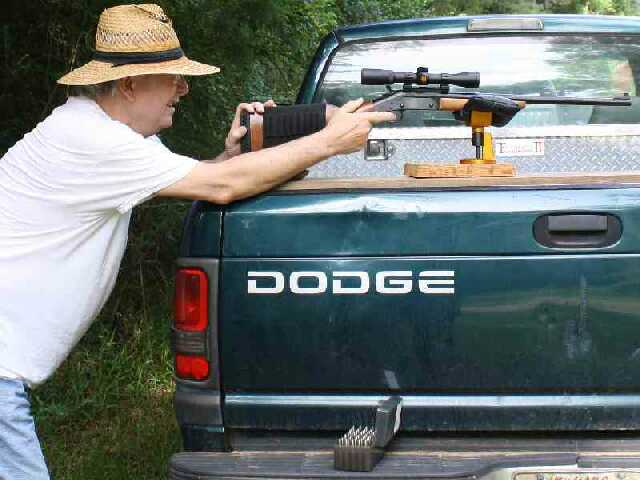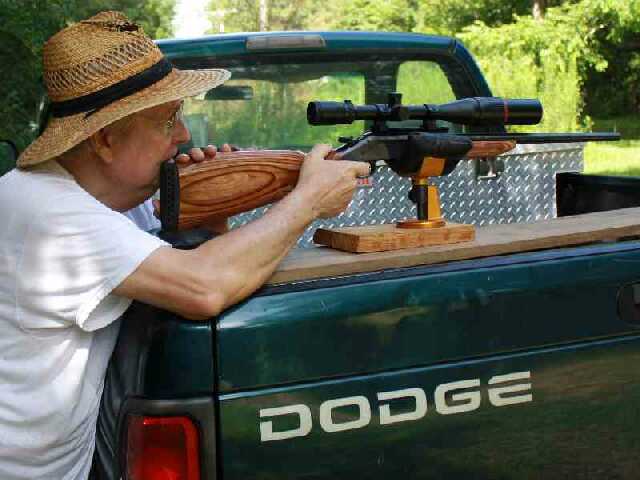A Brief Review
Copyright 2010 by Dennis Dezendorf
|
Many of us remember the break-open single shot shotgun we used in our youth. I've bought several of these little guns over the years, and I like them for teaching kids to shoot. They're simple to operate. Push a botton or move a lever and the barrel tips forward. Put a shell in the breech. Close the firearm. Cock the hammer with your thumb. Fire. Repeat as needed. The little guns are simple, intuitive and trouble free. They're also very safe. One cartridge, one shot, then you've got to do it all over again. For years, New England Firearms made millions of these shotguns through their Topper line. The original H&R went out of business in 1986, but in 1991 a new company, H&R 1871, was formed and started making firearms under the brands H&R and New England Firearms. The company produced a line of inexpensive, entry level rifles and shotguns. In November 2000, the assets of the company were purchased by Marlin, and in 2009 Remington acquired the group of companies. Handi-Rifles are easy to dissassemble, and some folks have several barrels for a single frame. If you've got a Handi-Rifle and send the frame to the factory, they'll fit a barrel to the action, although there are some barrels they won't fit to some frames. The full list of available barrels is can be found at the website. Additionally, there are guys who trade and swap barrels. These barrels can't be easily, simply interchanged like on some platforms (for example, on the Thompson/Center Contender). The guys over at the Graybeards Outdoors forum have lots of experience fitting barrels to frames and have put together a FAQ page for hobbyists to use. One of the links on the FAQ page takes you to a barrel fitting page. If you have any question about anything on a Handi-Rifle, go look at the FAQ page I've linked above. I have four of these little rifles, in calibers .45-70, .308 Winchester, 30-30 Winchester, and .223 Remington. plus one .410 shotgun. Each of these rifles are pawn shop rifles, most purchased used.
Some might wonder, with four rifles, why I haven't taken advantage of the barrel accessory program. There are several reasons. First, I've never been excited about switch-barrel rifles. I like a compete rifle for every barrel. Second, all these firearms were purchased from pawn shops. With the exception of one rifle, they were bought used. I actually ordered the 30-30 after scouring pawn shops for over a year. Third, these will eventually be grandkid rifles. I've got five grandsons. A couple of years ago, my wife recommended that I start picking up the occasional rifle when I find a good deal on one. Are Handi-Rifles a good deal? The answer to that question is highly individual, but in my battery of five firearms, I have roughly $1200.00 invested. New Handi-Rifles can be found online for about $300.00 US. Pawn shop prices for used rifles are less than that. Next, a word about safety. I consider the Handi-Rifle an extremely safe rifle. It holds only one shot, which is a training aid when teaching young shooters. Additionally, the rifle has a transfer-bar ignition system, which means that the trigger must be pulled completely to the rear for the rifle to fire. In other words, with the hammer at rest against the frame, the rifle absolutely cannot fire. You could pound on the hammer with complete safety, or drop the rifle without worrying that it might fire. I consider the Handi Rifle to be an extremely safe firearm for young shooters.
Let's start with the .45-70I bought mine well before the 2008 season, because I found it on the used gun rack at the pawn shop, and the price was right. For well under $200.00 I bought a short, light, handy rifle in a caliber that is serious medicine for the thickets and tight-spot hunting of central Louisiana. I immediately replaced the mid-barrel patridge sight with a Williams WGRS peep sight. My favorite load for this rifle is a Lee 405 grain round-nosed cast bullet pushed by 2.5cc of IMR 4895 powder to a velocity of about 1300 fps. I use a pinch of dacron fiberfill to hold the powder against the primer. Recoil is fairly mild yet duplicates the loading the old hunters used to wipe out the buffalo herds. That load gives me offhand groups under 2" at 50 yards, which is plenty accurate for deer-sized game, especially in the thickets where I hunt.
I use this rifle when I'm in the thickets, regardless of whether it's the primitive season or not. I cast my bullets out of pure soft lead, and I'm sure I can hit with the rifle. One word of caution about this Handi rifle and others. Many of the barrels on the Handi rifle are micro-groove rifled, a legacy of when Marlin bought H&R 1871. My rifle has an 8-groove microgroove barrel with 1:20 twist. However, It shoots cast bullets just fine. Some guys use modern, jacketed bullets in the .45-70 and report good results. Some folks scope their rifles, too. Either way, the Handi-Rifle in .45-70 is a serious hunting arm, capable of taking just about any animal on the North American continent.
The .308 WinchesterThe .308 Winchester is an iconic cartridge that never held much allure for me, probably because I fired so much of it when I was in the Army. It had no allure, somewhat like kissing my sister. Oh, there's affection, but no excitement in a sister's kiss, nor is there much excitement for me in the .308 Winchester. I considered it a machine gun cartridge. However, my youngest son has a rifle in .308 that gets wonderful accuracy out of Reloder 15 powder and a 168 grain Sierra MatchKing bullet, so I figured I'd give the cartridge another chance. I had a couple of pounds of RL15 and some 165 Sierra GameKing bullets, so I loaded them using the recipe for my son's rifle. A couple of weeks later I was at my private range and had the little rifle in the truck. I posted a target and after a half-dozen shots to zero the scope I fired a five shot group over the hood of my pickup truck. When I looked at the target, I was gratified to see that they all fell into two inches, nicely clustered around the aiming point. I still wasn't infatuated with the rifle, but had to admit that it was workmanlike in its accuracy. Two inches at 100 yards, fired off the hood of a pickup truck is good hunting accuracy. The chronograph showed me an average speed of 2800 fps from the load, which is perfectly acceptable velocity.
Several weeks later I was at a recreational range which features a gong target at 200 yards. The target is made out of heavy steel and is one foot square. I used the .308 on it and was able to hit the gong every time I pulled the trigger, going five hits for five shots. Where I hunt, my longest shot is two hundred yards, so I'm confident that this rifle will put down the venison at that range. I'm sure that with proper load development the rifle might be capable of minute-of-angle accuracy, certainly better accuracy than the two-minute accuracy I'm seeing now. While many gun writers brag about MOA accuracy out of every rifle they fire, we here at the Frugal Outdoorsman aren't necessarily interested in that level of performance. Sure, we like an accurate rifle, but we're more concerned about solid, repeatable hunting accuracy. This .308 Winchester is a solid performer, putting a 165 grain bullet within two inches of the target. This is a good solid hunting rifle. Mine weighs 8 lbs with the laminated stock and the scope.
The 30-30 WinchesterThe guys over at Graybeards Outdoor Forums have reported excellent accuracy with the 125 Sierra Gameking bullet and Hodgdon 4895 powder. I had no H4895, but I did have IMR 4895 and Reloder 15, both excellent powders for the cartridge, so I loaded some of each in varying charge weights and headed for the range. Results were mixed, at best. My .30-30 Handi-Rifle has a microgroove barrel, 1 turn in 10 inches. I was concerned that perhaps my barrel didn't like the 125 grain bullet, so I started working up loads with the 155 grain Hornady A-Max bullet. Results were again, mixed. As carefully as I knew how to fire the rifle, the group would stay at about 4 inches, sometimes turning in two groups, three inches apart. I played with powder, I played with seating depths, I tried every trick in my reloaders books, but I couldn't get the darned rifle to shoot. I expressed my frustration to Junior and he told me that he wanted to try some cast bullets in the little rifle. Microgroove barrels aren't supposed to shoot cast bullets, but Junior had some loaded for another rifle and wanted to try them in mine. So, one clear morning I put some rifles in the truck and headed for Junior's home in Tullos. Junior's load uses the Lyman 311041 bullet. It's a flat-nosed, gas checked design that Lyman designed especially for the .30-30. Like me, Junior lubes the bullets twice with Lee Liquid Alox, once before sizing to 0.309" and once after sizing. His ammo is indexed. Let's talk about indexing for a minute. ( See "Step 5" in Junior's article.) For best accuracy with cast bullets, it's important for all the bullets to start out in the barrel the same way. Indexing is achieved by marking the mold with a scribe or a punch, lightly marking the mold so that when you see the newly cast bullet, you can identify the mark. Then, the brass is marked, often with the simple expedient of a marker pen, so that all the cartridge brass is aligned to the mark with the bullet. For example, I'll often put a single dot of ink on the case rim, near a specific part of the manufacturers stamp. Then, when loading the bullet into the case, I'll align the mark on the bullet with the mark on the case. Then, I make sure that each case goes into the chamber with the mark on the rim pointing straight up. By taking these steps, I insure that all the bullets go into the barrel with the same orientation. This makes for more accurate ammo because the imperfections in the bullet hit the rifling the same way each time. Consistency is the key to accuracy. With indexed ammo, Junior and I went out to his private range, which consists of his front and side yards at his home. We set up a rest on the back of his pickup truck and he loaded some of his target ammo. After a couple of fouling shots to get the rifle on paper, Junior began the fine work of shooting for group. His skill paid off handsomely with a 3-shot group on the paper that measured just about 3/4th of an inch. Fine shooting with cast bullets, from a rickety rest on a pickup truck, with a six pound hunting rifle.
There's another load I like in the 30-30. It's the Speer 130 grain flat-tipped bullet with Reloder 15 powder. This load is accurate in my Winchester 94s, and I wanted to try it while we were shooting, so I handed Junior three of them and asked him to send them downrange. Three shots later, we had our answer. Those three shots went into, again, about 3/4ths of an inch. This far, my quest for a good spitzer load for this rifle has been frustrating. It doesn't like 155 grain Hornady A-Max bullets at all, shooting more like a shotgun than a rifle. I can't find the load it likes for 125 grain spitzers either. However, all is not lost. It shoots cast bullets fine and it shoots the little 130 grain Speer flatnose just fine. Either of these loads will work fine in the deer woods, and it's simply a matter of deciding which load to zero the rifle.
The 223 RemingtonDon't misunderstand, I consider the .223 marginal for deer and don't recommend that it be considered a main-line deer cartridge. But, it can handle bullets of good sectional density and send them at high velocity. Many deer are taken each year with the .223 Remington. So, one morning I walked into my favorite pawn shop and saw a Handi-Rifle on the rack. I asked the counter guy about it, and he handed it across. It's what they call the Ultra Hunter, with their mid-wieght barrel and laminated stocks. I happened to have a Swift Optics 6X18X44 scope at home with no rifle under it. I dickered with the counter guy, filled out a 4473, and walked out with a new rifle. I didn't reload for this cartridge, but I did have some factory .223 ammo at home. After mounting the scope, I took it to the range, and the little rifle performed just about like I expected. Nothing spectacular, but good serviceable shooting, with groups hovering around an inch with Federal bulk ammo. I decided the best accuracy I could find would have to be handloaded ammo, so I ordered dies and a box of Hornady 55 grain V-Max bullets. Then, I got busy on other projects and forgot about the little rifle. I did load some ammo, using both Reloder 15 powder and IMR 4895 powder, but I couldn't manage to get the little rifle to the range to test the ammo. So, when Junior and I decided to do some shooting, I put the .223 Handi in the truck. After we'd shot the 30-30, I brought out the .223 and asked Junior if he'd like to try it. He got comfortable behind his bench and put three shots into just about 3/8ths of an inch. It's a shooter.
I'm not sure what I'm going to do with this rifle now that I know it will shoot. I'm certainly going to zero it with the ammo it likes, but I don't do much varminting anymore. I'll probably use it to train grandkids and nephews. The light recoil, the big scope and the easy accuracy will make this a fine training rifle. Of course, if I ever get a chance to do some long-range crow sniping, this rifle would be the one I bring. Junior recommends I try coyote hunting with it. That's also an excellent idea.
My AssessmentI've also got grandsons who want to hunt with me, and these rifles will make excellent grandkid rifles. PawPaw can control the ammo, teach safety, and enjoy the safety of having one shot in the rifle. I can also enjoy the company of my grandsons in the woods. There's a lot to like in a Handi-Rifle. They're inexpensive, rugged, accurate, dependable. They're safe to use and fun to shoot. I'm convinced that they're great little rifles.
|
